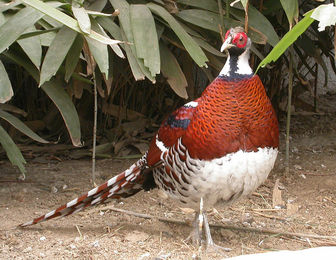Elliot's pheasant
The Elliot's Pheasant is endemic to China, where it lives in evergreen and mountain forests of southeastern China, at altitudes up to 6,200 feet. The diet consists mainly of seeds, leaves and berries.

Original source: Originally from zh.wikipedia; description page is (was) here10:51 2005?1?27? Snowyowls 1826x1413 (1,759,312??) (?????????????????)
Author: User Snowyowls on zh.wikipediaPermission(Reusing this file) This file is licensed under the Creative Commons Attribution-Share Alike 1.0 Generic license.You are free:to share – to copy, distribute and transmit the work
The Elliot's pheasant is classified as Vulnerable (VU), considered to be facing a high risk of extinction in the wild.
The Elliot's Pheasant is endemic to China, where it lives in evergreen and mountain forests of southeastern China, at altitudes up to 6,200 feet. The diet consists mainly of seeds, leaves and berries. The name commemorates the American ornithologist Daniel Giraud Elliot. Due to ongoing habitat lost, limited range and being hunted for food, the Elliot's Pheasant is evaluated as Vulnerable on the IUCN Red List of Threatened Species. It is listed on Appendix I of CITES. More
The Elliot's Pheasant (Syrmaticus ellioti ) is also known as the Chinese Barred-backed Pheasant or Bar-backed Pheasant. Its name commemorates the American ornithologist Daniel Giraud Elliot (1835-1915), author of A Monograph of the Phasianidae (1872) and one of the founders of the American Ornithologists Union. The Elliot's Pheasant is endemic to Southeastern China, where it lives in thick evergreen and mountain forests of southeastern China, at altitudes up to 6,200 feet (~1,900 meters). More
Elliot's Pheasant is not an easy bird to breed. The males are exceedingly pugnacious toward the females and the breeding pen should have lots of cover. It sometimes helps to clip one wing on the cock bird. Elliot's gain their adult pumage in the first year. A normal clutch is 6-8 eggs and the incubation period is 25 days. More

Original source: User Snowyowls on zh.wikipedia
Author: User Snowyowls on zh.wikipedia
Permission: Some rights reserved
Family : Phasianidae
Genus : Syrmaticus
Species : ellioti
Authority : (Swinhoe, 1872)
